
* Ironically, the Sabre, having been derived from a naval fighter, the FJ-1 Fury, became the basis for another series of naval fighters, the "FJ-2", "FJ-3", and "FJ-4 Fury". Various forms of the Sabre would also be used by the air forces of many other nations, and unique variants would be manufactured in a few of these countries. The Japanese would even design a jet trainer modeled on the Sabre, the Fuji "T-1".
* The US Navy had been slow to adopt swept-wing aircraft, since such machines seemed too "hot" to land on a carrier, but the war in Korea put Navy fighters up against the noticeably faster MiG-15, and the brass finally had to bite the bullet and go to swept wings. One of the most obvious solutions over the short term was just to modify the Air Force's excellent Sabre for carrier-deck operation. In early 1951, at the urging of the Navy, North American began investigation of a navalized Sabre, leading to award of a contract in March 1951 for three prototypes of a navalized F-86E.
Two prototypes were F-86Es modified with yoke-style arresting hooks, catapult attachment points, and a longer nosewheel leg to raise the angle of attack for carrier takeoffs and landings. No armament was fitted. These two aircraft were given the company designation "NA-179" and the Navy designation "XFJ-2 Fury". The third prototype, which was designated "NA-181" or "XFJ-2B" was basically a stock F-86E with four 20-millimeter cannon with 150 rounds per gun, in contrast to the F-86E's six 12.7-millimeter Browning guns. The XFJ-2B appears to have been strictly an armament test platform, with no carrier modifications. All three had the "all-moving tail", and were fitted with the J47-GE-13 engine. The XFJ-2B was the first to fly, on 27 December 1951, with famed test pilot Bob Hoover at the controls.
Carrier trials in late 1952 proved successful, if only barely so, and an order for 300 "FJ-2s" was placed, though only 200 of them were completed since the end of the Korean War reduced the need for new combat aircraft.
Production FJ-2s had slatted wings that folded straight up; a flat tailplane instead of the dihedral tailplane as used on the F-86E; a J47-GE-2 engine with 26.5 kN (2,700 kgp / 5,950 lbf) thrust; and four 20-millimeter cannon with 600 rounds total. The FJ-2 weighed about 450 kilograms (1,000 pounds) more than the F-86F. It appears that the Navy gave the new aircraft the designation of "FJ-2 Fury" to imply that it was a logical follow-on to the FJ-1 Fury, instead of an entirely new naval aircraft, in order to ease the program through Congress.
___________________________________________________________________
NORTH AMERICAN FJ-2 FURY:
___________________________________________________________________
wingspan:
11.31 meters (37 feet 2 inches)
span, wings folded:
6.89 meters (22 feet 7 inches)
wing area:
26.75 sq_meters (288 sq_feet)
length:
11.45 meters (37 feet 7 inches)
height:
4.14 meters (13 feet 7 inches)
height, wings folded:
4.78 meters (15 feet 8 inches)
empty weight:
5,355 kilograms (11,800 pounds)
loaded weight:
8,525 kilograms (18,790 pounds)
max speed at altitude:
970 KPH (600 MPH / 520 KT)
service ceiling:
12,700 meters (41,700 feet)
range with drop tanks:
1,595 kilometers (990 MI / 860 NMI)
___________________________________________________________________
Deliveries were slow, since North American was preoccupied with F-86F production for the USAF, and only 25 FJ-2s were delivered by the end of 1953. Delivery of the last of the 200 was in September 1954.
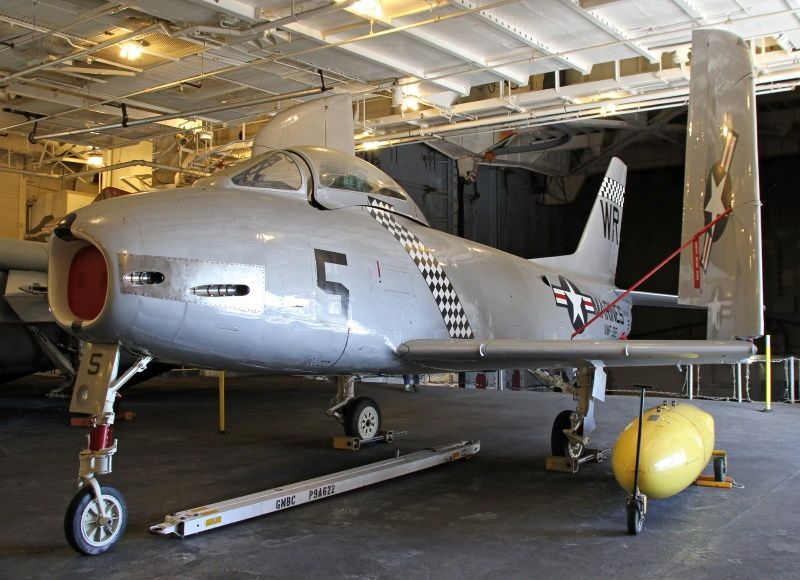
Early production FJ-2s were painted in Navy blue for Navy fighter squadrons. However, the Navy preferred the Grumman F9F-6 Cougar and the FJ-2s ended up equipping Marine squadrons, with the aircraft usually delivered in natural-metal finish. They were generally operated from land bases, since their carrier-deck handling was never regarded as particularly satisfactory.
BACK_TO_TOP* North American soon became aware that the FJ-2 left something to be desired. In March 1952, NAA began work on an uprated version of the Fury with a Wright J65-W-2 Sapphire engine, with the company designation of "NA-194" and Navy designation of "FJ-3". A contract for 389 FJ-3s was awarded to NAA in April 1952.
The Wright Sapphire was a license-built copy of the British Armstrong-Siddeley Sapphire engine, which provided 34.2 kN (3,500 kgp / 7,720 lbf) thrust. The new engine was tested in a modified FJ-2, which served as the prototype for the new Fury variant, first flying on 3 July 1953. The first production FJ-3 was completed in December 1953. The type was more enthusiastically accepted by the Navy. Production FJ-3s used a J65-W-4 engine, with the same thrust levels. The intake was noticeably enlarged to provide more airflow for the new engine. Ammunition supply for the four 20-millimeter cannon was increased to a total of 648 rounds, and heavier cockpit armor was fitted.
___________________________________________________________________
NORTH AMERICAN FJ-3 FURY:
___________________________________________________________________
wingspan:
11.31 meters (37 feet 2 inches)
span, wings folded:
6.86 meters (22 feet 6 inches)
wing area:
28.08 sq_meters (302.3 sq_feet)
length:
11.45 meters (37 feet 7 inches)
height:
4.16 meters (13 feet 8 inches)
height, wings folded:
4.8 meters (15 feet 9 inches)
empty weight:
5,535 kilograms (12,200 pounds)
loaded weight:
7,800 kilograms (17,200 pounds)
max speed at altitude:
1,000 KPH (625 MPH / 545 KT)
service ceiling:
14,900 meters (49,000 feet)
range with drop tanks:
1,595 kilometers (990 MI / 860 NMI)
___________________________________________________________________
Service deliveries of the FJ-3 began in 1954. An additional contract was placed that year, bringing the total of FJH-3s delivered to 538 before the end of 1956. The type equipped 12 Navy squadrons.
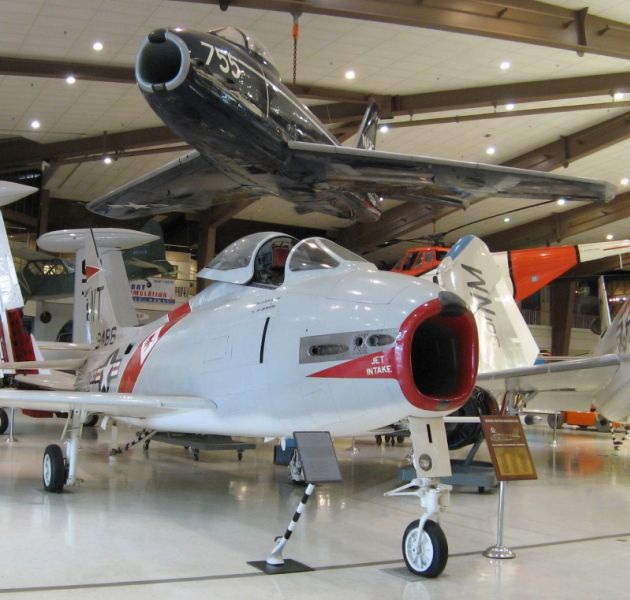
Modifications to the FJ-3 were introduced in 1955:
From the 345th FJ-3 on, Furies were equipped to carry the new Sidewinder AAM. Sidewinder-equipped Furies were designated "FJ-3M", and could carry a missile on each inboard stores pylon, for a total of two missiles. An inflight refueling probe was retrofitted to the left wing of many FJ-3s. A few FJ-3s were also modified to serve as control and chase aircraft for the Regulus long-range cruise missile, or target drones. The Furies modified as Regulus controllers were designated "FJ-3D", while the drone controllers were designated "FJ-3D2".
BACK_TO_TOP* Work on the final naval Sabre, the "NA-209" or "FJ-4", began in December 1953, leading to award of contracts for two "NA-208" prototypes, followed by production contracts for 177 aircraft. First flight was on 28 October 1954.
The FJ-4 was intended as an extended-range attack aircraft, and was one of the most highly modified of the Sabre series. The airframe was completely redesigned to accommodate 50% more fuel, with the wing and tail redesigned as well. Only the wingtips folded on the new wing. The landing gear was also redesigned and provided a wider track. Surprisingly, although the FJ-4 used basically the same powerplant as the FJ-3, a J65-W-16A engine with 34.2 kN (3,500 kgp / 7,720 lbf) thrust, the bigger FJ-4's performance matched or bettered that of its predecessor, a tribute to cleaner aerodynamics.
The FJ-4 looked something like a Sabre on steroids, with a fatter fuselage, a redesigned canopy trailing into a dorsal spine running back to the tail, a wing wider at the root and narrower at the tip, and a taller tail. To trim weight, some cockpit armor was removed, and the ammunition supply for the four 20-millimeter cannon was reduced to a total of 548 rounds. Four stores pylons were standard, and Sidewinders could be carried on all four pylons for the air combat mission. The FJ-4 was also fitted with a midair refueling probe on the left wing.
___________________________________________________________________
NORTH AMERICAN FJ-4 FURY:
___________________________________________________________________
wingspan:
11.91 meters (39 feet 1 inch)
span, wings folded:
8.38 meters (27 feet 6 inches)
wing area:
31.46 sq_meters (338.7 sq_feet)
length:
11.07 meters (36 feet 4 inches)
height:
4.24 meters (13 feet 11 inches)
height, wings folded:
4.8 meters (15 feet 9 inches)
empty weight:
5,990 kilograms (13,210 pounds)
loaded weight:
9,130 kilograms (20,130 pounds)
max speed at altitude:
1,015 KPH (630 MPH / 550 KT)
service ceiling:
14,270 meters (46,800 feet)
range:
2,390 kilometers (1,485 MI / 1,290 NMI)
___________________________________________________________________
The "FJ-4B" sub-variant first flew in late 1956, and was further optimized for the low-level strike role. It had six stores pylons instead of four, two additional speed brakes, structural reinforcement to handle a greater weapons load, and a LABS installation for nuclear weapon delivery.
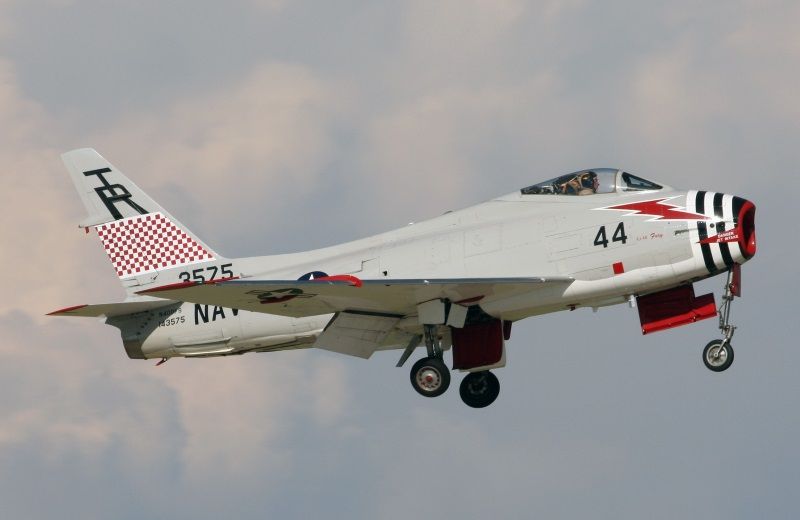
The Navy introduced a "buddy tanker" refueling system in 1957, allowing almost any aircraft capable of carrying external stores to carry a tank with a drogue-refueling line. This scheme greatly increased the effective range of carrier-based aircraft.
Another late-1950s enhancement was the Martin "Bullpup" air-to-ground missile. The Bullpup was a radio-guided missile, which a pilot guided to a target up to 5 kilometers (3 miles) away by using a joystick to keep a flare on the end of the missile centered in his gunsight. An FJ-4B could carry five of these weapons, along with a guidance pack. First test firings of the Bullpup from FJ-4s were in 1957, with operational deployment in 1959. A number of FJ-4s were also modified to operate as control and chase aircraft for the Regulus, and these aircraft were designated "FJ-4Ds".
An additional order for FJ-4s placed in 1956 gave a final total of 222 FJ-4s, with the last delivered in 1958, completing a total production of 1,112 Furies of all types.
* When the Navy adopted the tri-service aircraft designation scheme in September 1962, Furies still in service were redesignated as follows:
By that time, they were approaching the end of their days. Apparently a few FJ-4Bs performed air strikes into Laos in 1962, with one aircraft damaged so badly by anti-aircraft fire that it had to be written off after landing. This seems to have been the only combat service of any of the Furies. They were entirely in Reserve service by the end of 1962, and were completely out of service by the mid-1960s.
NAA made an effort to revive the Fury, responding to a 1963 Navy request for a new attack aircraft with an updated FJ-4, the "NA-295". It was to be powered by the Pratt & Whitney TF30 bypass turbojet, had a multimode radar in a radome on the lower lip of the intake, and bristled with stores pylons. The Navy was interested, but chose the Ling-Temco-Vought A-7 instead.
BACK_TO_TOP* When Canada joined NATO in 1949, the Canadian government decided to ramp up military aircraft production to meet increased commitments, and so in August of that year, Canadair of Montreal signed an agreement with North American to build 100 Sabres, using plans and parts provided by NAA. The two companies had already worked together during the war, with Canadair producing NAA T-6 Harvard trainers.
The first Canadair Sabre, the "CL-13 Sabre Mark 1", was really an F-86A-5. Only one was built, as a manufacturing exercise. It was assembled from parts supplied by NAA and first flew in August 1950. The first Canadair production variant was the "CL-13 Sabre Mark 2", which was effectively an F-86E-1. 350 Mark 2s were completed between January 1951 and August 1952. This number includes the 60 provided to the USAF as the F-86E-6. Most of the Canadian Sabres went to Europe, while the Canadian homeland was protected by the Avro CF-100 Canuck.
The Canadians were interested in fitting their indigenous Avro Canada Orenda Mark 3 engine, with 26.7 kN (2,720 kgp / 6,000 lbf) thrust, to the Sabre. NAA installed the Orenda to an F-86A-5 pulled from their own production line as an experiment, giving the modified aircraft the designation "F-86J". The experimental fit was very successful, with the F-86J demonstrating substantially improved performance.
Canadair then performed the same transplant on a Sabre Mark 2 pulled from their production, resulting in the "CL-13 Sabre Mark 3", which first flew in September 1952. The Sabre Mark 3 was a purely experimental aircraft, since the Orenda was not ready for production at the time. For the moment, Canadair production went on to the "CL-13 Sabre Mark 4", which was effectively identical to an F-86E-10. 438 Mark 4s were built in 1952 and 1953. Most of the Mark 4s ended up in the hands of the British Royal Air Force (RAF). Since the British did not have a swept-wing fighter at the time, they obtained some 428 Mark 4 Sabres as an interim measure while awaiting delivery of the new Hawker Hunter. The RAF gave their Sabres the designation "Sabre F.4". The RAF Sabres only served into 1955 and 1956, when the Hunter finally began to be delivered to RAF squadrons.
The "CL-13A Sabre Mark 5" first flew in the summer of 1953. The Mark 5 was the first truly Canadian Sabre, using the Avro Orenda 10 engine, with 29.8 kN (2,950 kgp / 6,500 lbf) thrust. The new engine provided significantly improved performance, including a doubled climb rate. The Mark 5 also incorporated the "solid 6-3" stretched wing, which was retrofitted to many Mark 4s and even some Mark 2s. 370 Mark 5s were built, with 75 delivered to the West German Luftwaffe.
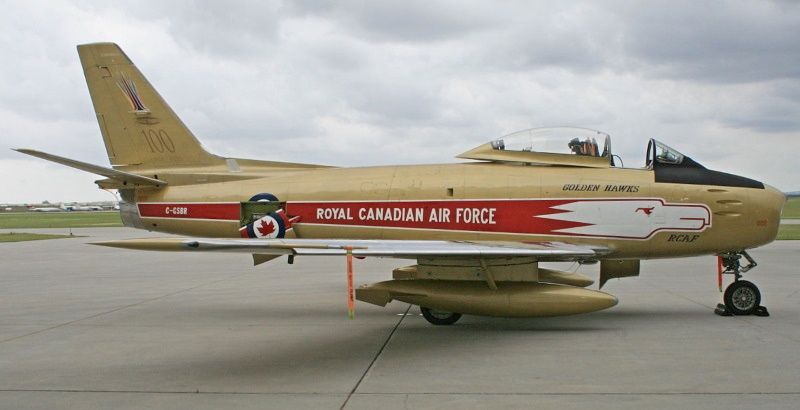
The final Canadair variant was the "CL-13B Sabre Mark 6", with first flight in October 1954. The Mark 6 was fitted with an Orenda 14 engine with 32.4 kN (3,300 kgp / 7,275 lbf) thrust, giving it better performance than any subvariant of the F-86F. Later production also featured the "F-40" long slatted wing.
___________________________________________________________________
CANADAIR SABRE MARK 6:
___________________________________________________________________
wingspan:
11.92 meters (39 feet 2 inches)
wing area:
29.11 sq_meters (313.4 sq_feet)
length:
11.43 meters (37 feet 6 inches)
height:
4.5 meters (14 feet 9 inches)
empty weight:
4,815 kilograms (10,620 pounds)
loaded weight:
6,630 kilograms (14,615 pounds)
max speed at altitude:
1,000 KPH (620 MPH / 540 KT)
range with drop tanks:
2,405 kilometers (1,495 MI / 1,300 NMI)
___________________________________________________________________
647 Sabre Mark 6s were completed, with the last rolled out in October 1958. 382 went to the RCAF, 225 to West Germany, 34 to South Africa, and 6 to Colombia. Total Canadair Sabre production amounted to 1,807 aircraft.
BACK_TO_TOP* A small number of Sabres, 112 in all, were built by Commonwealth Aircraft Corporation (CAC) in Australia. Although they were externally very similar to other Sabre fighter variants, they featured major structural redesign to accommodate the powerful Rolls-Royce RA.7 Avon engine with 33.4 kN (3,400 kgp / 7,500 lbf) thrust, and revised armament of two 30-millimeter Aden revolver cannon, with a total of 162 rounds of ammunition.
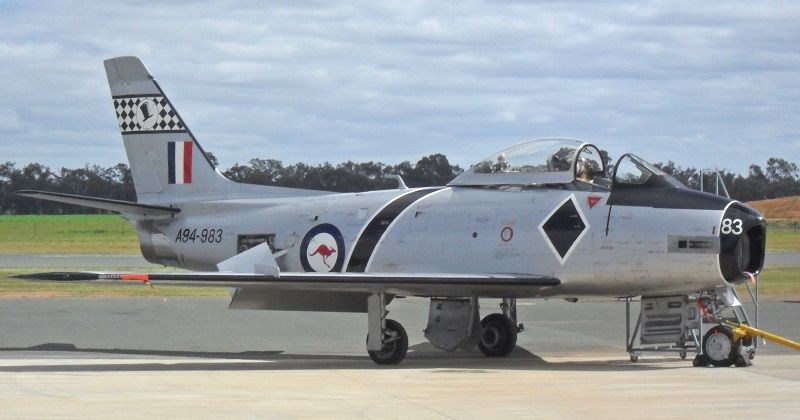
The major visible difference of the Aussie Sabres was that they had two big gun ports on the nose, instead of six relatively little ones. The Avon was lighter than the J47 and required substantial airframe changes to balance center of gravity and provide more intake airflow. The fit of the twin Aden cannon was not only very different from that of the six Brownings, but the cannon mounts had to be very sturdy since the weapons were hefty, powerful, and had a high rate of fire.
The first of these Australian Sabres was the single "CA-26", which featured a standard F-86E/F short-slatted wing and all-flying tail with the redesigned fuselage. It first flew on 3 August 1953, leading to an RAAF order for 70 CAC Sabres. The production batch was of 22 "CA-27 Sabre Mark 30s", similar to the CA-26 prototype and with imported Avon engines. The first of them flew in July 1954, with initial service delivery in August 1954.
The "CA-27 Sabre Mark 31" featured the Australian-built Avon Mark 20 engine and the "solid 6-3" wing. Some sources claim this was a slatted wing, but most sources specifically state that the "F-40" long slatted wing was not fitted to any Australian Sabres, leaving the matter murky. The wing was retrofitted to Mark 30s as well. 20 Mark 31s were built.
The definite Australian Sabre was the "CA-27 Sabre Mark 32", which had the Australian-built Avon 26 engine and four stores pylons. The Avon 26 had a throttle scheme in which fuel flow was automatically reduced when the cannon were fired, reducing the chance of a flame-out due to gun gas ingestion. A total of 69 Mark 32s was built, in three batches.
___________________________________________________________________
COMMONWEALTH CA-27 SABRE MARK 32:
___________________________________________________________________
wingspan:
11.92 meters (39 feet 2 inches)
wing area:
29.11 sq_meters (313.4 sq_feet)
length:
11.43 meters (37 feet 6 inches)
height:
4.39 meters (14 feet 5 inches)
empty weight:
5,500 kilograms (12,120 pounds)
loaded weight:
7,255 kilograms (16,000 pounds)
max speed at altitude:
980 KPH (610 MPH / 530 KT)
service ceiling:
16,800 meters (55,000 feet)
range with drop tanks:
1,850 kilometers (1,150 MI / 1,000 NMI)
___________________________________________________________________
After experiments with launching Sidewinder AAMs in 1959, all surviving Mark 31s and Mark 32s were refitted to launch the missile. The Sidewinder-equipped CAC Sabres remained in service with the RAAF through the 1960s, with the last phased out in 1971.
BACK_TO_TOP* The Japanese were the third-biggest users of the Sabre after the Americans and Canadians; in fact, they liked the Sabre so much that they built a tandem two-seat trainer modeled on it, the Fuji "T-1". It was the first indigenously-designed Japanese jet aircraft to be developed since World War II. Although the T-1 was a new-design aircraft, it was clearly inspired by the F-86, with a distinctive forward fuselage for cadet and instructor that somewhat concealed its Sabre roots.
In 1953, the Japanese government resurrected the country's aircraft industry, with Fuji Heavy Industries receiving large government contracts. The company began development of an axial-flow turbojet of their own design, the "JO-1", and then won a contract for a new jet trainer, the "T1F1", to be powered by the JO-1 or a derivative of that engine. The government ordered seven T1F1s, with the first scheduled to fly in 1957. However, Fuji didn't quite meet that schedule. The JO-1 engine first ran in 1954, leading to the improved J3 engine, which ran in July 1956. The J3 was then transferred to the Japanese Ishikawajima-Harima company, with the transfer delaying the engine program and trainer program.
The prototype of the trainer performed its first flight on 19 January 1958, powered by the Rolls-Royce Orpheus engine. Although the plan was to use the J-3 engine, original plans for the trainer had foreseen the use of a foreign-built engine, and the delays in the engine program forced Fuji to go into production with the Orpheus engine. The result was the "T-1A", which entered JASDF service in May 1960. It was originally named "Hatsutaka (Young Hawk)", but the name was never used in service. Even though the Orpheus was derated to 15.8 kN (1,610 kgp / 4,000 lbf), this was still more engine than the airframe had been originally designed for, and the T-1A was overpowered.
The problems with the J3 engine were eventually ironed out, leading to the "T-1B", powered by a J3-3 turbojet with 11.8 kN (1,200 kgp / 2,650 lbf) thrust. This was about half the thrust as had been available to the F-86A, but the empty weight of the T-1B was also half as much, even though its dimensions were similar; the discrepancy probably had much to do with the fact that the T-1B was not designed for combat service, though it was also a slenderer aircraft than the Sabre. First flight of the T-1B was in May 1960, with service deliveries beginning in 1961. The T-1A and T-1B were externally identical. Final production of the T-1 series was in 1963, after delivery of two prototypes, four pre-production aircraft, 40 T-1As, and 20 T-1Bs, for a total of 66 aircraft. The T-1s were used in the intermediate trainer role.
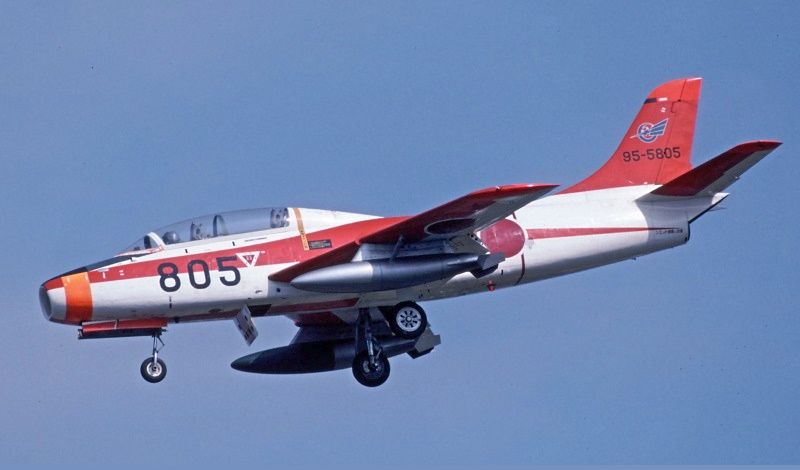
The T-1 had two underwing pylons and usually flew with two Sabre-type twin-fin drop tanks. It could also be fitted with a single 12.7-millimeter gun in the nose, and could carry Sidewinder AAMs or other stores on the two underwing pylons -- but in practice, it almost never flew armed.
___________________________________________________________________
FUJI T-1A:
___________________________________________________________________
wingspan:
10.49 meters (34 feet 5 inches)
wing area:
22.22 sq_meters (239.2 sq_feet)
length:
12.12 meters (39 feet 9 inches)
height:
4.08 meters (13 feet 5 inches)
empty weight:
2,420 kilograms (5,335 pounds)
max loaded weight:
5,000 kilograms (11,025 pounds)
max speed at altitude:
860 KPH (535 MPH / 465 KT)
service ceiling:
14,400 meters (47,250 feet)
range with drop tanks:
1,860 kilometers (1,155 MI / 1,005 NMI)
___________________________________________________________________
Three T-1Bs refitted with the uprated J3-7 engine with 13.7 kN (1,400 kgp / 3,090 lbf) were flown -- this conversion being referred to as "T-1C" in some sources -- but plans to re-engine other T-1s with the J3-7 were dropped. Plans were also considered for an updated T-1 variant with a "stepped" cockpit to provide the instructor with a better forward view, plus an Adour turbofan engine, but nothing came of this study.
The T-1 trainer was finally phased completely out of service in 1999, having been replaced by the Kawasaki T-4.
BACK_TO_TOP* After first-line service in the US, Canada, Australia, Japan, Italy, Britain, France, West Germany, the Netherlands, Norway, Pakistan, and Columbia, used Sabres were passed on to dozens of nations. The bulk were ex-USAF F-86Fs, which were generally updated to F-86F-40 standard, but the exports included good numbers of Canadair Sabres of various marks, plus some F-86Ds, F-86Ks, CAC Sabres, and small quantities of other variants.
Second-hand Sabre users included Argentina, Bangladesh, Bolivia, Burma, Denmark, Ethiopia, Greece, Honduras, Indonesia, Iran, Iraq, Malaysia, Peru, the Philippines, Portugal, Saudi Arabia, South Korea, Spain, Taiwan, Thailand, Tunisia, Turkey, Venezuela, and Yugoslavia. For the most part, these Sabres saw little action.
However, Pakistani Sabres particularly distinguished themselves in the 1965 war with India. On 7 September 1965, Pakistani Squadron Leader Mohammed Mahmood Alam engaged a set of Indian Hawker Hunters, shooting one down and then, after a few minutes of maneuver, destroying four more in 30 seconds, becoming an ace in a single sortie. Squadron Leader Alam shot down nine Indian aircraft in the short war, taking out the last with a Sidewinder missile. He personally claimed almost half the aircraft India lost during the conflict -- though it should be mentioned that Indian sources strongly dispute Alam's story. The Sabre saw action again with Pakistan during their 1971 war with India.
Sabres also saw combat in Taiwanese service. In 1958, the Communist Chinese blockaded the island of Quemoy, and Nationalist Chinese F-86Fs, armed with the new Sidewinder heat-seeking missiles, were sent into the sky to engage Red MiG-15s and MiG-17s. This was the first combat use of the Sidewinder; the Nationalists claimed dozens of kills, but these figures are difficult to confirm. A story floated around for a long time that one of the Sidewinders fired during these squabbles was a dud and ended up wedged into a MiG, which was removed and sent to the Soviets to be copied as the "Atoll" air-to-air missile. This sounded like an urban myth, but Russian documents that came to the surface after the end of the Cold War validated it.
Some Sabres lingered on towards the end of the century as orange-patterned QF-86 target drones, operated into the mid-1990s by the US Navy at their facility at Point Mugu, California. A few Sabres are in private hands, as elite personal toys.
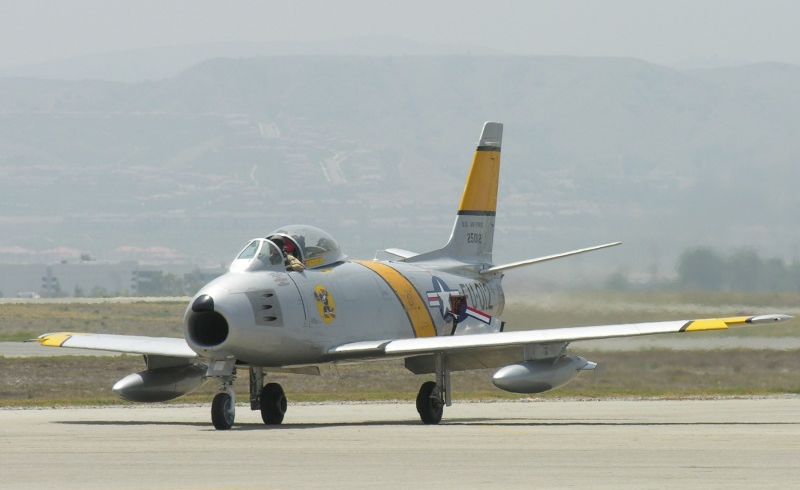
* With as many Sabres as were built, there were of course a good number of one-off modifications:
* A list of Sabre & Fury production runs as follows:
* I recollect reading interesting stories about the Sabre interceptors in a book a long time ago, so long ago that I do not remember the book's title, and am fuzzy on the details. Some of the tales about the F-86D that I recall from it were amusing, however.
The F-86D was one of the first combat jets with an afterburner, and its initial operational years roughly matched that of the first UFO scares. The North American air defense system in those days left continental airspace tightly controlled, and airliners that strayed off course would be quickly intercepted and checked out. Fighters would also be scrambled to intercept airliners just for practice. F-86D pilots liked to sneak up on airliners at night and get in, say, the 1:00 or 2:00 position not too far away with their lights off. They would then engage afterburner and take off in a ball of fire, bewildering the airliner's crew and likely inspiring wild stories after the airliner got back down on the ground.
That afterburning engine was clearly a source of troubles. The book reprinted a cautionary cartoon from an F-86D tech manual that showed the engine melted out of the bottom of the fuselage, in order to encourage pilots to follow proper procedures.
The book also gave a mixed report on the actual effectiveness of the F-86D. During one exercise, bombers were sent up in order to be hunted by the F-86Ds. When the bombers landed again, their pilots laughed that they hadn't seen a trace of the hunters. Then the gun-camera films of the interceptors were developed, and revealed kill after kill. The F-86Ds had been guided on a precision collision-course intercept by their ground controllers and avionics, to cross the path of their victims so quickly that they were there and gone, unseen. However, according to another story, one bomber pilot got onto the ground controllers' frequency and completely jammed the system by continuously reciting "Mary had a little lamb" over the radio link. The interceptors never touched him.
The Sabre Dog's FFAR armament seems somewhat dubious in hindsight. My colleague Bill Marr said that he had worked as a service tech on the F-86D's E-4 fire-control system and its solid-state successors. He said that he had seen films of the Sabre Dog firing its rockets and commented: "It was a wonder they could hit anything, the way those rockets twisted around." Folding-fin rockets tend to be unstable until their fins deploy, which is why they were fired in groups.
In 1956, a Hellcat target drone "slipped the leash" and broke radio control over southern California, and two rocket-armed F-89D Scorpion interceptors were sent up to shoot it down. They dumped their entire rocket loads on it and didn't scratch it, though they did cause several brush fires and sent rocket fragments into local homes. The Hellcat ran out of gas and fell to earth in the desert. Fortunately, nobody was hurt in the incident, though it was a big embarrassment to the US Air Force.
It appears few pilots had much confidence in unguided rocket armament. The problem was that there were few good alternatives. Cannon wouldn't have been effective in a collision-course intercept -- it went by much too fast, and a few hits with cannon shells wouldn't have been effective -- and guided AAMs were in a primitive state of development at the time.
* Sources for this document include:
Illustration credits:
* Revision history:
v1.0 / 10 jul 96 v1.1 / 05 aug 96 / Tightened up metric usage. v2.0 / 02 oct 96 / Added materials on the Fury, other additions. v2.1 / 15 oct 96 / Minor changes. v3.0 / 01 may 01 / Broke into chapters, rewrote, expanded. v3.0.1 / 01 feb 02 / Review & polish. v3.0.2 / 01 aug 02 / Review & polish. v3.1.0 / 01 sep 04 / General update. v3.1.1 / 01 jul 06 / Review & polish. v3.1.2 / 01 aug 08 / Review & polish. v3.1.3 / 01 jul 13 / Review & polish. v3.2.0 / 01 jun 15 / Review & polish. v3.2.1 / 01 may 17 / Review & polish. v3.2.2 / 01 apr 19 / Review & polish. v3.3.0 / 01 jan 22 / Illustrations update. v3.3.1 / 01 dec 23 / Review & polish. (+)BACK_TO_TOP
